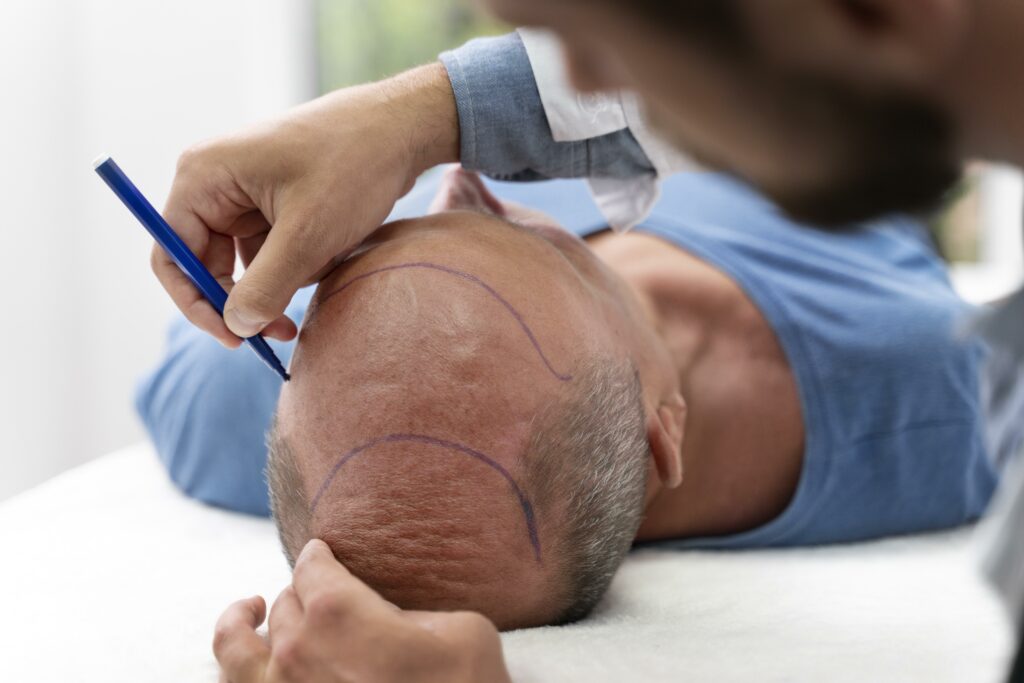Do you stare at your reflection, watching your hairline retreat day by day? You’re not alone. Over 6.5 million men in the UK experience hair loss, and the emotional impact extends far beyond appearance – it destroys confidence, damages career prospects, and strains relationships.
Here’s the life-changing news: Modern hair transplant technology has revolutionized hair restoration. Doctors have eliminated the painful “strip” surgeries that left obvious scars. Today’s advanced techniques – CHI and FUE – deliver completely natural hairlines that nobody will detect.
But here’s the problem: Most people spend months researching online, get confused by conflicting information, and ultimately delay treatment while their hair loss worsens. Every month you wait, you lose more precious donor hair that you could have saved.
This guide ends that confusion today. In this blog, you will get the exact information about the need to choose between CHI (Comfortable Hair Implant) and FUE (Follicular Unit Extraction) – the two leading methods in London’s top clinics.
Quick Answer: CHI (Comfortable Hair Implant) uses direct implantation technology and achieves 95-98% graft survival rates with faster recovery, while FUE (Follicular Unit Extraction) remains the proven gold standard and delivers 90-95% survival rates. CHI costs more but provides superior comfort; FUE offers wider availability and better cost-effectiveness.
Key Takeaway: Both CHI hair transplant London and FUE hair transplant London deliver permanent, natural-looking results. Choose CHI when you want the latest technology and comfort, choose FUE when you prefer proven reliability and value.
What Is In This Blog:
- What Is a CHI Hair Transplant? (Complete Definition)
- What Is an FUE Hair Transplant? (Complete Definition)
- CHI vs FUE: Direct Comparison (2025 Analysis)
- Which Hair Transplant Method Should You Choose? (Decision Framework)
- Supporting Hair Treatments in London (Complementary Options)
- Emerging Trends in Hair Transplants and Hair Restoration (2025)
- London Hair Transplant Clinic Selection Guide
- Hair Transplant Cost Considerations London (Value Analysis)
- Frequently Asked Questions
- Why Choose Shumaila’s London for Your Hair Transplant
- Conclusion: Making the Right Choice for You
What Is a CHI Hair Transplant? (Complete Definition)
CHI (Comfortable Hair Implant) represents an advanced hair restoration technique that utilizes specialized implantation pens to directly place hair follicles into the scalp without creating recipient channels beforehand.
The process Steps:
- Extraction: Surgeons remove hair follicles from the donor area (back of the head).
- Direct Implantation: The Implanter pen creates a channel and places the follicle simultaneously.
- Precision Placement: The Doctor positions each hair at the optimal angle and depth.
- Immediate Sealing: Process eliminates the gap between channel creation and implantation.
Technology Benefits:
- Graft Survival Rate: Achieves 95-98% success (highest available).
- Recovery Time: Allows return to normal activities in 2-3 days.
- Scarring: Creates virtually invisible micro-punctures.
- Precision: Offers computer-controlled angle and depth adjustments.
- Comfort Level: Delivers minimal pain during and after the procedure.
Comfortable Hair Implant London clinics report 40% faster healing compared to traditional FUE methods.
What Is an FUE Hair Transplant? (Complete Definition)
FUE (Follicular Unit Extraction) stands as the gold standard hair transplant method, where surgeons extract individual hair follicles from the donor area and manually implant them into recipient sites through pre-created channels.
The process steps:
- Follicle Extraction: Doctors remove individual hairs using 0.8-1.0mm punches
- Graft Preparation: Technicians sort and prepare follicles carefully
- Channel Creation: Surgeon makes tiny incisions in the recipient area
- Manual Implantation: The Doctor places each follicle by hand into the prepared sites
Proven Benefits:
- Success Rate: 90-95% graft survival (industry standard)
- Track Record: 15+ years of documented results
- Versatility: Suitable for all hair loss patterns
- Availability: Offered by most qualified surgeons worldwide
- Scarring: Tiny dot scars that fade completely
Follicular Unit Extraction London has helped over 50,000 patients achieve natural-looking results.
CHI vs FUE: Direct Comparison (2025 Analysis)
| Comparison Factor | CHI (Comfortable Hair Implant) | FUE (Follicular Unit Extraction) | Winner |
| Graft Survival Rate | 95-98% | 90-95% | CHI |
| Recovery Time | 2-3 days | 3-5 days | CHI |
| Procedure Comfort | Minimal pain | Moderate discomfort | CHI |
| Technology Level | Latest 2024 innovation | Proven since 2010 | CHI |
| Surgeon Availability | Limited Specialists | Widely available | FUE |
| Cost Range | Higher investment | More affordable | FUE |
| Long-term Results | Excellent | Excellent | Tie |
| Scar Visibility | Almost invisible | Tiny dots fade | CHI |
| Procedure Time | 6-8 hours | 8-12 hours | CHI |
| Hair Density Achievable | Very High | High | CHI |
Key Differences Explained:
Technology Approach:
- CHI: Single-step direct implantation.
- FUE: Two-step extraction, then implantation.
Tissue Trauma:
- CHI: Minimal handling, less damage.
- FUE: More manipulation during the process.
Precision Control:
- CHI: Computer-assisted accuracy.
- FUE: Surgeon skill-dependent.
Which Hair Transplant Method Should You Choose? (Decision Framework)
Choose CHI Hair Transplant London If:
- You want maximum comfort during treatment.
- Budget is not the primary concern (premium technology).
- You need the fastest recovery (return to work in 2-3 days).
- You want the highest graft survival (95-98% success rate).
- You prefer the latest technology (2024 innovation).
- You have limited donor hair (need maximum efficiency).
Ideal CHI Candidates:
- Busy professionals needing a quick recovery
- First-time hair transplant patients
- Those with previous failed procedures
- Patients with sensitive scalps
- Anyone wanting premium results
Choose FUE Hair Transplant London If:
- You want proven, reliable results (with over 15 years of success).
- You prefer a cost-effective option (one that offers better value).
- You need extensive hair restoration (large areas).
- You want more surgeon choices (widely available).
- You’re comfortable with standard recovery (3-5 days).
- You trust established methods over new technology.
Ideal FUE Candidates:
- Extensive hair loss patterns.
- Budget-conscious patients.
- Those preferring proven methods.
- Patients need multiple sessions.
- Anyone wanting a variety.
Recovery Optimization Tips:
- Sleep was elevated for the first week.
- Avoid touching treated areas.
- Follow the medication schedule exactly.
- Use prescribed shampoos only.
- Avoid sun exposure for 30 days.
- No heavy exercise for 10 days.
Supporting Hair Treatments in London (Complementary Options)
1. PRP (Platelet-Rich Plasma) Therapy
What it is: Your blood is processed to concentrate healing platelets, then injected into the scalp.
Scientific backing: 70+ peer-reviewed studies confirm effectiveness
Benefits for transplant patients:
- Increases graft survival by 15-20%
- Accelerates the healing process
- Strengthens existing hair
- Reduces post-procedure inflammation
Treatment protocol:
- Session 1: Day of transplant
- Session 2: 1 month post-procedure
- Session 3: 3 months post-procedure
- Maintenance: Every 6 months
Success rate: 85% of patients show improved results.
2. Mesotherapy for Hair Growth
Definition: Micro-injections of vitamins, minerals, and medications directly into scalp tissue.
Active ingredients include:
- Biotin and B-vitamins
- Amino acids
- Minoxidil
- Finasteride
- Growth factors
Clinical benefits:
- Reduces DHT (hair loss hormone) locally
- Improves blood circulation by 40%
- Nourishes follicles directly
- Extends the hair growth phase
Treatment frequency: Monthly sessions for 6 months, then quarterly maintenance
3. Low-Level Laser Therapy (LLLT)
FDA approval: Cleared for androgenetic alopecia treatment in 2007
How it works:
- 650-670nm red light wavelength
- Increases ATP production in cells
- Stimulates blood flow to follicles
- Reverses hair follicle miniaturization
Clinical evidence:
- 93% of users show reduced hair loss
- 64% experience new hair growth
- Works best combined with transplants
Device options:
- In-clinic panels (30-minute sessions)
- Home devices (caps, combs, helmets)
- Treatment frequency: 3x per week
4. Hair Exosome Therapy with Microneedling
Cutting-edge science: Uses stem cell-derived exosomes (growth factor vesicles)
Process explained:
- Exosome application: Growth factors applied to the scalp
- Microneedling: 0.5-1.5mm needles create micro-channels
- Enhanced absorption: Exosomes penetrate deeper into tissue
- Hydration boost: Hyaluronic acid maintains moisture
Regenerative benefits:
- Activates dormant hair follicles
- Improves scalp health dramatically
- Enhances transplant healing
- Promotes natural hair thickness
Treatment schedule: 3 sessions spaced 4 weeks apart, then maintenance every 6 months
Emerging Trends in Hair Transplants and Hair Restoration (2025)
Hair restoration continues to evolve, and 2025 brings a wave of innovation that puts comfort, precision, and personalization at its center. Clinics in London and around the world now use advanced tools and regenerative science to deliver faster healing and natural-looking results. Here are the top trends shaping the industry.
Surgeons Use AI for Hair Mapping
Surgeons now utilize AI-powered software to scan the scalp, predict future hair loss, and plan the precise placement of every follicle. This technology enhances precision, creating hairlines that appear natural and complement each patient’s unique features.
No-Shave FUE Keeps Procedures Discreet
Clinics offer no-shave FUE, allowing patients to restore their hair without shaving their entire scalp. This discreet option will enable professionals to return to work or their social life quickly, without apparent signs of surgery.
Patients Choose Beard and Eyebrow Transplants
More people now request transplants for beards and eyebrows. These procedures add thickness, reshape facial features, and help patients achieve their ideal look.
Doctors Boost Results with Regenerative Therapies
Specialists combine PRP, stem-cell injections, and exosome therapy with transplants. These treatments accelerate healing, enhance graft survival, and reactivate dormant follicles.
Clinics Offer Quick Micro-Grafting Treatments
In London, clinics perform Autologous Micrografting Treatment (AMT). Doctors collect a tiny scalp sample, process it into growth-factor injections, and reintroduce it—all in under an hour. Patients leave with minimal downtime and a proactive solution to hair loss.
Patients Travel Abroad for Affordable Packages
Medical tourism continues to thrive. Countries like Turkey attract patients with affordable transplant packages that include surgery, accommodations, and post-surgery care.
Patients Arrive Informed and Demanding
Today’s patients research online, watch video diaries, and study before-and-after photos before booking. Clinics respond by offering transparent consultations and setting realistic expectations.
Researchers Experiment with Hair Cloning
Scientists are exploring hair cloning as a potential future solution to the limited supply of donors. They aim to extract a few follicles, multiply them in labs, and reimplant them to create full coverage.
Scientists Develop Nanotech Therapies
Researchers test nanoparticles that deliver medicine directly to hair follicles. This approach could transform how doctors treat baldness and thinning hair.
People Embrace Laser Therapy
Patients use Low-Level Laser Therapy (LLLT) devices, such as helmets and combs, to stimulate regrowth. Many combine LLLT with surgery or use it as a non-invasive treatment.
London Hair Transplant Clinic Selection Guide
Essential Qualifications to Verify:
- Surgeon credentials: GMC registration + ISHRS membership.
- Experience level: Minimum 1,000 procedures performed.
- Specialization focus: Hair restoration as primary practice.
- Facility accreditation: CQC registered medical facility.
- Technology availability: Both CHI and FUE options.
Questions to Ask During Consultation:
- “How many CHI/FUE procedures do you perform monthly?”
- “Can I see before/after photos of similar cases?”
- “What’s included in the total cost?”
- “Who will perform the actual procedure?”
- “What happens if I’m not satisfied with the results?”
Hair Transplant Cost Considerations London (Value Analysis)
Factors Affecting Investment:
- Number of grafts needed (1,000-4,000, typical range)
- Technique selected (CHI vs FUE pricing difference)
- Surgeon experience level (premium for top specialists)
- Clinic location (central London vs suburbs)
- Package inclusions (aftercare, follow-ups, touch-ups)
Value Optimization Strategies:
- Compare total packages, not just procedure costs
- Factor in time off work (CHI = fewer days needed)
- Consider revision rates (a higher initial cost may prevent the need for corrections)
- Evaluate financing options (0% APR often available)
- Account for travel costs if considering overseas options
Insurance and Financing:
- NHS coverage: Not available for cosmetic hair loss
- Private insurance: Rarely covers elective procedures
- Clinic financing: Most offer 0-24% APR payment plans
- Medical loans: Specialized lenders offer competitive rates
Frequently Asked Questions
Which is better: CHI or FUE hair transplant?
CHI offers more comfort, faster recovery, and higher graft survival, while FUE remains the trusted, widely used method. The best treatment plan usually depends on your needs and goals.
Is a hair transplant permanent?
Yes. Because the follicles that were transplanted are resistant to the hormone (DHT) that causes hair loss, the results are permanent. Surrounding natural hair may still thin over time.
Does a hair transplant hurt?
No. Surgeons use local anaesthesia, making the procedure pain-free. Patients usually feel only mild soreness or tightness for a few days after treatment.
How long does recovery take after CHI or FUE?
Most patients heal within 7–10 days. CHI tends to heal slightly faster with less swelling, whereas FUE may require a few extra days for the redness to fade.
When can I expect to see results from my hair transplant?
New hair growth begins around 3–4 months, with thicker results visible by 6–9 months, and full results typically appear within 12–18 months.
Can women have a hair transplant?
Yes. Both CHI and FUE are suitable options for women with thinning or patchy hair, provided there is sufficient donor hair available.
Are there any risks with CHI or FUE?
Risks are minimal. Temporary redness, swelling, or shedding may occur, but serious complications are rare when experts perform the procedure.
What percentage of hair transplants work?
Both CHI and FUE have a very high success rate, often over 90–95%. Success depends on the quality of donor hair, the surgeon’s expertise, and proper aftercare.
Why Choose Shumaila’s London for Your Hair Transplant
For more than 20 years, Shumaila’s has delivered advanced aesthetic treatments to thousands of patients. With clinics across London and Essex, we make world-class hair restoration accessible and results-driven.
Here’s why patients choose us for their transformation:
- Rely on leading specialists: Our internationally trained surgeons perform every procedure with precision and care.
- Experience the latest methods: We use advanced CHI and FUE technologies to ensure natural, lasting results.
- Get a plan built for you: We design every hairline and treatment plan around your unique needs and goals.
- Trust our transparency: We keep pricing transparent, honest, and free of hidden costs.
- Recover with confidence: Our expert aftercare team is here to support you at every stage of your healing journey.
When you book with Shumaila’s, you take the first step toward natural results, renewed confidence, and expert-led care from London’s trusted hair restoration clinics.
Our Client’s Journey
From Hair Loss to Confidence
FUE Hair Transplant
“I wasn’t just losing my hair—I was losing my confidence and the person I saw in the mirror.”
That’s how our Patient described his struggle during his first consultation with our hair restoration team.
Years of thinning left visible bald spots along his crown and hairline. Temporary fixes failed, and with each passing day, his self-esteem continued to drop. But everything changed when he chose FUE Hair Transplant with our expert team.
Personalized Hair Restoration Plan
- Procedure: Follicular Unit Extraction (FUE)
- Grafts Used: (4,500)
- Target Areas: Crown & frontal hairline
- Recovery: Minimal downtime; visible results in 3 months, full results by 9–12 months
The Results
Today, our client has a thick, natural-looking hairline—and his confidence is back.
“I feel like myself again—just better.”
Conclusion: Making the Right Choice for You
CHI (Comfortable Hair Implant) and FUE (Follicular Unit Extraction) both deliver excellent, permanent hair restoration results when performed by qualified surgeons in London.
Choose CHI if: You prioritize comfort, latest technology, fastest recovery, and have a budget that allows for premium results.
Choose FUE if: You want proven reliability, more surgical options, cost-effectiveness, and are comfortable with standard recovery times.
Success factors for both methods:
- Qualified, experienced surgeon selection
- Realistic expectation setting
- Proper aftercare compliance
- Patience during the growth process
- Complementary treatment consideration
The bottom line: Both techniques can restore your confidence and appearance. The “best” choice is the one that aligns with your specific needs, lifestyle, and goals.
Ready to Start your Hair Restoration Journey? Book consultations with qualified London specialists offering both CHI and FUE options. Compare recommendations, view results, and make an informed decision based on expert guidance tailored to your unique situation. Your new hair – and renewed confidence – are just a consultation away.
BOOK YOUR FREE CONSULTATION TODAY!
“This comprehensive guide provides factual information for educational purposes. Always consult qualified medical professionals for personalized advice regarding hair restoration procedures.”













